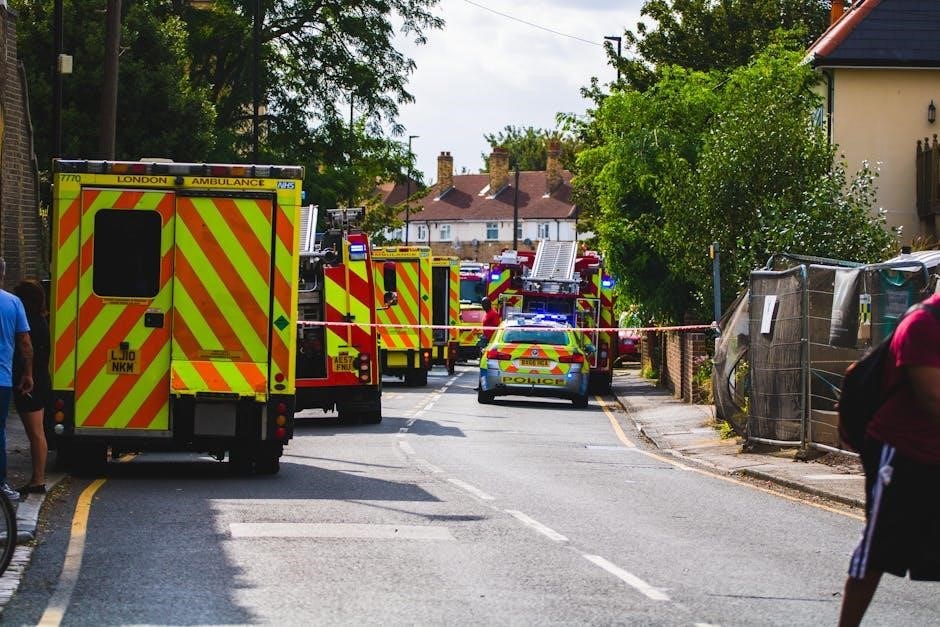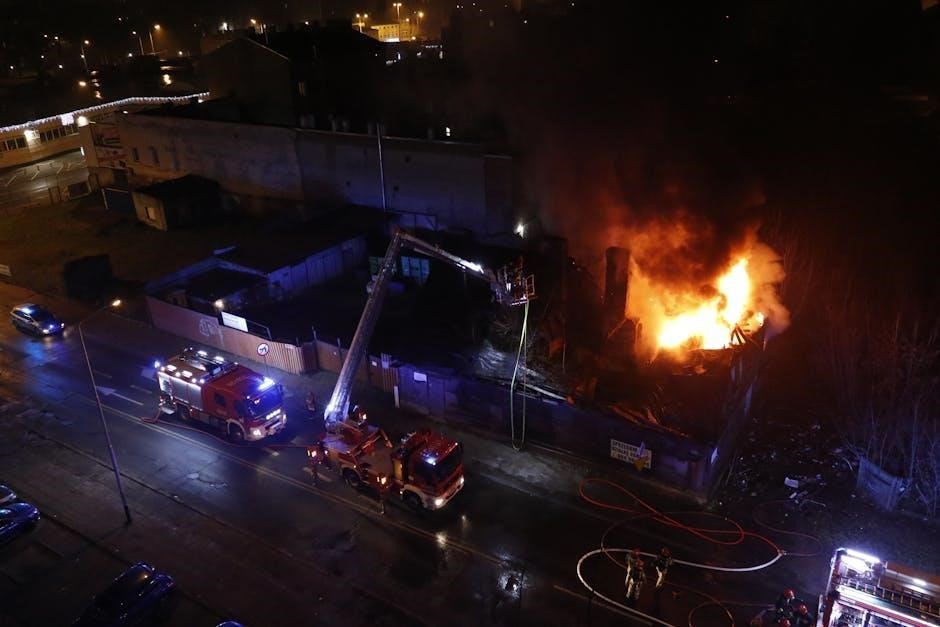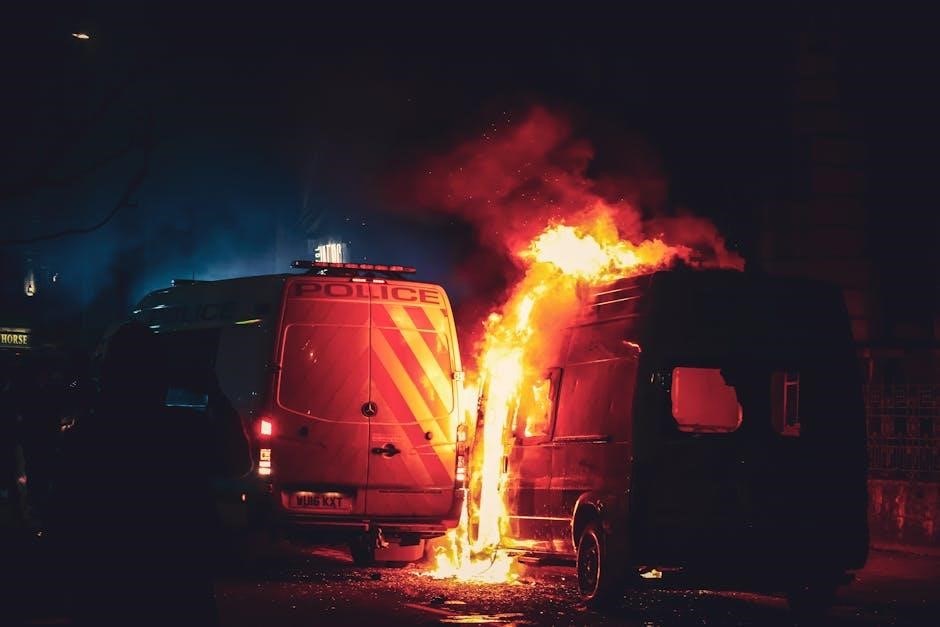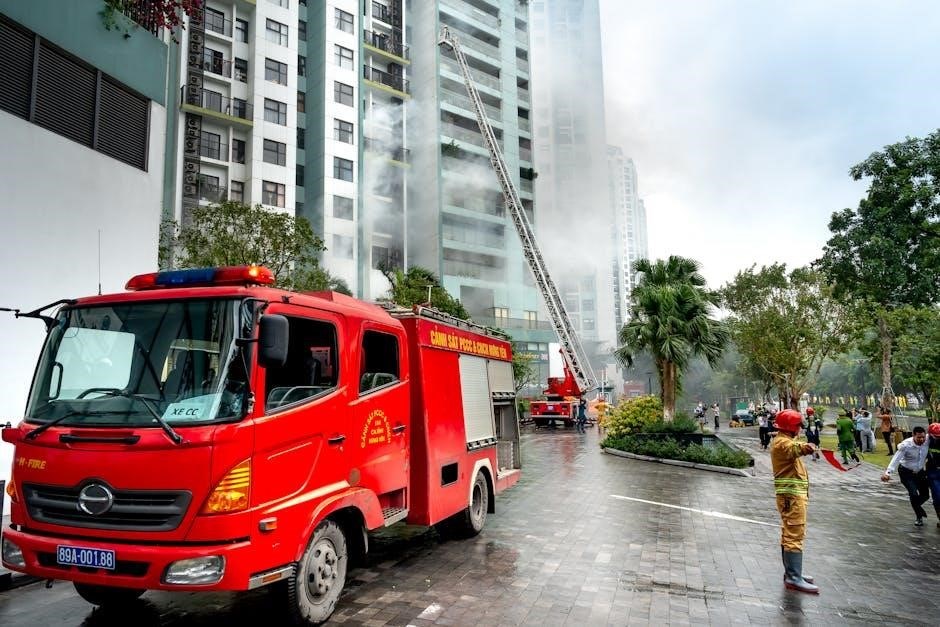NWCG Incident Response Pocket Guide (IRPG) Overview
The NWCG Incident Response Pocket Guide (IRPG) establishes standards for wildland fire incident response. It provides essential information for operational engagement‚ risk management‚ fire environment awareness‚ all-hazard response procedures‚ and aviation management protocols‚ ensuring a safe and effective response.

NWCG Incident Response Pocket Guide (IRPG) Overview
Purpose of the IRPG
The primary purpose of the NWCG Incident Response Pocket Guide (IRPG) is to serve as a readily accessible field reference for wildland fire personnel. It aims to standardize incident response procedures‚ ensuring a cohesive and coordinated approach across various agencies and jurisdictions. The IRPG offers crucial guidelines‚ checklists‚ and best practices for managing wildland fire incidents‚ promoting firefighter safety and operational effectiveness.
Furthermore‚ the guide provides a concise summary of essential information related to operational engagement‚ risk management‚ and fire environment considerations. It facilitates quick decision-making in dynamic and high-pressure situations. By offering a consolidated source of critical data‚ the IRPG enhances situational awareness and supports informed decision-making at all levels of incident command. It also supports all-hazard responses‚ including vehicle accidents‚ HazMat spills‚ and search and rescue.
Additionally‚ the IRPG plays a vital role in training and professional development‚ serving as a valuable resource for firefighters of all experience levels. Regular review and practical application of the guide’s contents contribute to improved proficiency and preparedness on the fireline.

NWCG Incident Response Pocket Guide (IRPG) Overview
Target Audience
The NWCG Incident Response Pocket Guide (IRPG) is primarily designed for wildland fire personnel actively involved in incident response operations. This includes firefighters ranging from entry-level Firefighter Type 2 to experienced Division Supervisors‚ as well as initial attack and extended attack Incident Commanders. The guide serves as a valuable resource for individuals responsible for making critical decisions on the fireline.
Moreover‚ the IRPG is intended for use by personnel from various agencies‚ including federal‚ state‚ local‚ tribal‚ and territorial entities‚ ensuring a consistent and standardized approach to wildland fire management across different jurisdictions. Its applicability extends to all-hazard incident response scenarios‚ making it relevant to a broader range of emergency responders.
The guide also serves as a vital training aid for aspiring firefighters and incident management personnel‚ facilitating their understanding of essential concepts and procedures. By providing a comprehensive overview of best practices and operational guidelines‚ the IRPG contributes to the development of competent and well-prepared wildland fire professionals.
Key Components of the IRPG
The IRPG encompasses operational engagement guidelines‚ risk management principles‚ fire environment considerations‚ all-hazard response procedures‚ and aviation management protocols. These components ensure a comprehensive approach to incident management and firefighter safety.
Operational Engagement Guidelines
The IRPG provides essential operational engagement guidelines that establish clear standards for wildland fire incident response. These guidelines emphasize the importance of a well-coordinated and structured approach to incident management. They are designed to ensure that all personnel involved in the response understand their roles and responsibilities‚ promoting effective teamwork and communication.
The guidelines address critical aspects of incident operations‚ including initial assessment‚ resource allocation‚ and strategic decision-making. They provide a framework for incident commanders and other leaders to make informed choices based on the current situation and available resources. The emphasis is placed on adapting strategies as the incident evolves‚ maintaining flexibility while adhering to established protocols.
Moreover‚ the operational engagement guidelines encourage continuous evaluation of the incident’s progress and the effectiveness of implemented strategies. They promote the use of best practices and lessons learned from past incidents to improve future responses. The ultimate goal is to ensure the safety of all personnel involved while effectively mitigating the incident’s impact.
Risk Management Principles
The Incident Response Pocket Guide (IRPG) underscores the significance of risk management principles as a cornerstone of effective incident response. These principles provide a systematic approach to identifying‚ assessing‚ and mitigating risks associated with wildland fire incidents and other emergencies.
The IRPG emphasizes the importance of proactive risk assessment‚ encouraging incident personnel to identify potential hazards before they escalate into significant threats. It provides guidance on evaluating the likelihood and potential consequences of various risks‚ enabling informed decision-making and resource allocation. The principles stress the need to implement appropriate control measures to minimize or eliminate identified risks.
Furthermore‚ the risk management principles within the IRPG advocate for continuous monitoring and evaluation of implemented control measures to ensure their effectiveness. They encourage adaptive management‚ allowing for adjustments to strategies and tactics as the incident evolves and new information becomes available. These principles promote a culture of safety and accountability‚ fostering a proactive approach to risk mitigation throughout the incident response process.
Fire Environment Considerations
The Incident Response Pocket Guide (IRPG) places significant emphasis on fire environment considerations‚ recognizing the critical role they play in shaping fire behavior and influencing incident response strategies. Understanding the fire environment is paramount for ensuring firefighter safety and achieving effective fire suppression.
The IRPG provides guidance on assessing key environmental factors such as weather conditions‚ fuel types‚ and topography. It highlights the importance of monitoring changes in wind speed and direction‚ temperature‚ and humidity‚ as these factors can dramatically impact fire spread and intensity. The guide offers insights into identifying different fuel types‚ including grasses‚ shrubs‚ and timber‚ and understanding their respective burning characteristics.
Furthermore‚ the IRPG emphasizes the importance of considering topographical features such as slope‚ aspect‚ and elevation‚ as they can influence fire behavior and create unique challenges for firefighters. Understanding how these factors interact is essential for predicting fire movement‚ identifying potential hazards‚ and developing effective suppression tactics.
All-Hazard Response Procedures
The Incident Response Pocket Guide (IRPG) extends its applicability beyond wildland fire incidents to encompass all-hazard response procedures. This reflects the understanding that incident management principles and practices are transferable across a range of emergency situations‚ including natural disasters‚ accidents‚ and other unforeseen events. The IRPG provides a framework for responders to effectively assess‚ plan‚ and execute operations in diverse scenarios.
The guide outlines procedures for incident assessment‚ including identifying the nature and scope of the incident‚ assessing potential hazards‚ and determining resource needs. It emphasizes the importance of establishing a clear command structure and maintaining effective communication among all responders. The IRPG also provides guidance on implementing safety protocols‚ managing resources‚ and coordinating with external agencies.
Furthermore‚ the IRPG addresses specific considerations for different types of hazards‚ such as hazardous materials incidents‚ search and rescue operations‚ and medical emergencies. It provides checklists and guidelines for managing these situations effectively‚ ensuring the safety of both responders and the public.
Aviation Management Protocols
Aviation management protocols are crucial during incident response‚ particularly in wildland firefighting and other large-scale operations. The IRPG provides comprehensive guidelines for the safe and effective use of aircraft in support of incident objectives. These protocols cover various aspects of aviation operations‚ including pre-flight planning‚ air traffic control‚ and emergency procedures.
The guide emphasizes the importance of conducting thorough risk assessments before any aviation operation. This includes evaluating weather conditions‚ terrain‚ and potential hazards. The IRPG also outlines procedures for establishing clear communication channels between ground personnel and aircrews‚ ensuring seamless coordination.
Furthermore‚ the IRPG addresses specific aviation-related tasks‚ such as aerial reconnaissance‚ water and retardant drops‚ and personnel transport. It provides guidance on selecting appropriate aircraft‚ managing helispots‚ and implementing safety measures to prevent accidents. The IRPG also includes checklists and procedures for responding to aviation mishaps‚ ensuring a coordinated and effective response. Aviation management protocols are crucial for the safe and effective use of aircraft.

Updates in the 2025 Edition
The 2025 IRPG includes key updates such as nighttime fuel estimates‚ a mental health checklist‚ and a firing checklist. These additions enhance situational awareness and responder well-being on the fireline.
Nighttime Fuel Estimates
The inclusion of nighttime fuel estimates in the 2025 edition of the IRPG marks a significant enhancement to operational planning and safety during wildland fire incidents. Wildland fire behavior is drastically affected by the changes in environmental conditions that occur after sunset. Lower temperatures‚ increased humidity‚ and decreased wind speeds alter fuel moisture content and availability‚ which directly impacts the intensity and spread of fires.
These nighttime fuel estimates provide firefighters and incident commanders with crucial data to anticipate and prepare for these shifts. By understanding how fuels behave differently at night‚ personnel can make informed decisions about tactics‚ resource allocation‚ and potential hazards. This information is especially vital for ensuring firefighter safety during extended operations that continue into the night. The estimates assist in predicting changes in fire behavior‚ supporting proactive strategies to mitigate risks and optimize suppression efforts. This addition allows for more accurate assessments and adaptive strategies‚ enhancing overall effectiveness.
The integration of nighttime fuel estimates reflects the ongoing commitment to providing relevant‚ timely‚ and actionable information to wildland fire responders.
Mental Health Checklist
Recognizing the intense psychological demands placed on wildland firefighters‚ the 2025 IRPG incorporates a dedicated Mental Health Checklist. This addition underscores the importance of addressing the mental and emotional well-being of personnel engaged in high-stress incident response scenarios. The checklist serves as a practical tool for self-assessment and peer support‚ prompting individuals to reflect on their mental state and identify potential signs of distress or burnout.
By including specific indicators related to stress‚ fatigue‚ and emotional strain‚ the checklist facilitates early detection of mental health challenges. It encourages firefighters to proactively monitor their well-being and seek assistance when needed. Furthermore‚ the checklist promotes a culture of open communication and support within incident teams‚ fostering an environment where individuals feel comfortable discussing their mental health concerns. This tool aids in normalizing conversations about mental health‚ reducing stigma‚ and ensuring that firefighters have access to resources and support systems.
The Mental Health Checklist signifies a proactive approach to firefighter wellness‚ integrating mental health considerations directly into incident response protocols. This helps maintain overall operational effectiveness.
Firing Checklist
The 2025 IRPG introduces a comprehensive Firing Checklist designed to enhance safety and effectiveness during firing operations. This checklist serves as a systematic guide for personnel involved in planned ignitions‚ ensuring that all critical steps are considered and executed meticulously. The checklist encompasses pre-burn planning‚ site preparation‚ ignition procedures‚ and post-burn monitoring‚ promoting a structured and standardized approach to firing operations.
By incorporating specific items related to weather conditions‚ fuel types‚ terrain characteristics‚ and resource availability‚ the checklist facilitates a thorough assessment of the burn environment. It prompts firefighters to evaluate potential hazards‚ mitigate risks‚ and adapt their strategies accordingly. The checklist also emphasizes the importance of clear communication‚ coordination‚ and adherence to established protocols‚ minimizing the likelihood of errors or unintended consequences.
Furthermore‚ the Firing Checklist promotes accountability and continuous improvement‚ encouraging personnel to document their actions‚ evaluate their performance‚ and identify areas for refinement. This checklist helps maintain operational efficiency and ensures safer‚ more controlled burn operations.
To effectively use the IRPG‚ regular review and familiarization are essential. Knowing how to quickly locate information‚ especially in high-stress situations‚ is critical for making informed decisions and ensuring firefighter safety.
Regular Review and Familiarization
Consistent review of the NWCG Incident Response Pocket Guide (IRPG) is paramount for all wildland fire personnel. Familiarizing oneself with its contents enhances preparedness and enables rapid access to crucial information during incident response. Regular review ensures that firefighters understand operational engagement guidelines‚ risk management principles‚ and fire environment considerations.
Knowing the location of specific checklists‚ such as the medical incident checklist or the firing checklist‚ is crucial for efficient decision-making on the fireline. The IRPG contains a wealth of knowledge‚ but its effectiveness hinges on the user’s ability to quickly retrieve pertinent data. Regularly practicing with the IRPG‚ simulating incident scenarios‚ and quizzing oneself on key topics will solidify understanding and improve recall under pressure.
Furthermore‚ keeping abreast of updates and revisions‚ such as those introduced in the 2025 edition‚ is vital. These updates often reflect lessons learned from past incidents and incorporate new best practices. By dedicating time to regular review and familiarization‚ firefighters can maximize the IRPG’s utility and contribute to safer‚ more effective incident management.

Using the IRPG Effectively
Practical Application on the Fireline
The true value of the NWCG Incident Response Pocket Guide (IRPG) lies in its practical application during real-world incidents. On the fireline‚ the IRPG serves as a readily accessible reference for making informed decisions under pressure. When facing complex scenarios‚ firefighters can quickly consult the IRPG for guidance on operational engagement‚ risk assessment‚ and safety protocols.
The IRPG’s checklists and guidelines provide a structured approach to incident management‚ ensuring that critical steps are not overlooked. For example‚ the aviation management protocols offer essential information for coordinating aerial operations‚ while the all-hazard response procedures assist in handling various emergency situations. Furthermore‚ the IRPG aids in effective communication by providing standard terminology and reporting formats.
By consistently using the IRPG on the fireline‚ firefighters develop a deeper understanding of its contents and become more proficient in its application. This familiarity translates to increased confidence‚ improved decision-making‚ and enhanced safety for themselves and their fellow crew members. The IRPG is not merely a document to be studied; it is a tool to be actively employed‚ refined‚ and relied upon in the dynamic environment of incident response.
